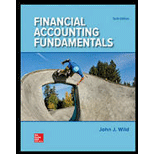
Prepare the journal entries to record the disposal of the machine on January 3 under each of the given situations.
Explanation of Solution
Journal entry is a set of economic events which can be measured in monetary terms. These are recorded chronologically and systematically.
Rules of Debit and Credit:
Following rules are followed for debiting and crediting different accounts while they occur in business transactions:
- Debit, all increase in assets, expenses and dividends, all decrease in liabilities, revenues and equities.
- Credit, all increase in liabilities, revenues, and equities, all decrease in assets, and expenses.
Prepare the journal entries to record the disposal of the machine on January 3 under each of the given situations as follows:
Situation 1: Company B sold the machine for $18,250 cash.
| Date | Account Title and Explanation | Post Ref |
Debit ($) | Credit ($) |
| January 2 | Cash | 18,250 | ||
| 24,625 | ||||
| Loss on disposal of Machinery (1) | 1,125 | |||
| Machinery | 44,000 | |||
| (To record the loss on disposal of machinery) |
Table (1)
- Cash is an asset, and it increases the value of assets by $18,250. Therefore, debit the cash account with $18,250.
- Accumulated depreciation is a contra asset, and it increases the asset by $24,625. Therefore, debit Accumulated depreciation with $24,625.
- Loss on sale of machinery is loss of the company and it decreases the value of equity by $1,125. Therefore, debit the loss on sale of machinery with $1,125.
- Machinery is an asset, and it decreases the value of assets by $44,000. Therefore, credit machinery account by $44,000.
Working note:
Calculate the loss on disposal of machinery
Situation 2: The machine is traded in for a newer machine having a $60,200 cash price. A $25,000 trade-in allowance is received and the balance is paid in cash.
| Date | Account Title and Explanation | Post Ref |
Debit ($) | Credit ($) |
| January 2 | Machinery (new) | 60,200 | ||
| Accumulated Depreciation –Machinery | 24,625 | |||
| Machinery (old) | 44,000 | |||
| Cash (2) | 35,200 | |||
| Gain from sale of machinery (3) | 5,625 | |||
| (To record the gain from disposal of old machinery and purchase new machinery) |
Table (2)
- Machinery is an asset, and it increases the value of assets by $60,200. Therefore, debit the machinery account with $60,200.
- Accumulated depreciation is a contra asset, and it increases the asset by $24,625. Therefore, debit Accumulated depreciation with $24,625.
- Machinery (old) is an asset, and it decreases the value of assets by $44,000. Therefore, credit machinery account by $44,000.
- Cash is an asset, and it decreases the value of assets by $35,200. Therefore, credit the cash account with $35,200.
- Gain from sale of machinery is revenue of the company and it increases the value of equity by $5,625. Therefore, debit the loss on sale of machinery with $5,625.
Working note:
Calculate the balance cash paid for purchase of new machinery
Calculate the gain from disposal of machinery
Situation 3: The machine is traded in for a newer machine having a $60,200 cash price. A $15,000 trade-in allowance is received and the balance is paid in cash.
| Date | Account Title and Explanation | Post Ref |
Debit ($) | Credit ($) |
| January 2 | Machinery (new) | 60,200 | ||
| Accumulated Depreciation -Machinery | 24,625 | |||
| Loss on disposal of Machinery (5) | 4,375 | |||
| Machinery | 44,000 | |||
| Cash (4) | 45,200 | |||
| (To record the loss from disposal of old machinery and purchase new machinery) |
Table (3)
- Machinery is an asset, and it increases the value of assets by $60,200. Therefore, debit the machinery account with $60,200.
- Accumulated depreciation is a contra asset, and it increases the asset by $24,625. Therefore, debit Accumulated depreciation with $24,625.
- Loss on sale of machinery is loss of the company and it decreases the value of equity by $4,375. Therefore, debit the loss on sale of machinery with $4,375.
- Machinery is an asset, and it decreases the value of assets by $44,000. Therefore, credit machinery account by $44,000.
- Cash is an asset, and it decreases the value of assets by $45,200. Therefore, credit the cash account with $45,200.
Working note:
Calculate the balance cash paid for purchase of new machinery
Calculate the gain from disposal of machinery
Want to see more full solutions like this?
Chapter 8 Solutions
FINANCIAL ACCT.FUND(LL)W/ACCESS>CUSTOM<
- Please provide the correct solution to this financial accounting question using valid principles.arrow_forwardI need help finding the accurate solution to this general accounting problem with valid methods.arrow_forwardCan you help me solve this general accounting problem with the correct methodology?arrow_forward

 AccountingAccountingISBN:9781337272094Author:WARREN, Carl S., Reeve, James M., Duchac, Jonathan E.Publisher:Cengage Learning,
AccountingAccountingISBN:9781337272094Author:WARREN, Carl S., Reeve, James M., Duchac, Jonathan E.Publisher:Cengage Learning, Accounting Information SystemsAccountingISBN:9781337619202Author:Hall, James A.Publisher:Cengage Learning,
Accounting Information SystemsAccountingISBN:9781337619202Author:Hall, James A.Publisher:Cengage Learning, Horngren's Cost Accounting: A Managerial Emphasis...AccountingISBN:9780134475585Author:Srikant M. Datar, Madhav V. RajanPublisher:PEARSON
Horngren's Cost Accounting: A Managerial Emphasis...AccountingISBN:9780134475585Author:Srikant M. Datar, Madhav V. RajanPublisher:PEARSON Intermediate AccountingAccountingISBN:9781259722660Author:J. David Spiceland, Mark W. Nelson, Wayne M ThomasPublisher:McGraw-Hill Education
Intermediate AccountingAccountingISBN:9781259722660Author:J. David Spiceland, Mark W. Nelson, Wayne M ThomasPublisher:McGraw-Hill Education Financial and Managerial AccountingAccountingISBN:9781259726705Author:John J Wild, Ken W. Shaw, Barbara Chiappetta Fundamental Accounting PrinciplesPublisher:McGraw-Hill Education
Financial and Managerial AccountingAccountingISBN:9781259726705Author:John J Wild, Ken W. Shaw, Barbara Chiappetta Fundamental Accounting PrinciplesPublisher:McGraw-Hill Education





